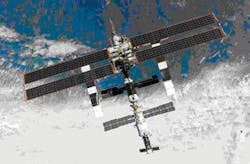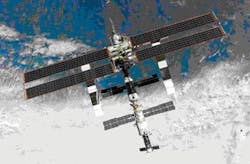Manned space missions, International Space station, get increases in 2008 NASA budget request
By John McHale
WASHINGTON - Officials at NASA are looking for increased funding for the International Space Station and manned space systems such as the Orion Crew Exploration Vehicle and other programs that fulfill President Bush’s goal of reaching the Moon by the end of the decade and then Mars and beyond.
The overall 2008 NASA budget request is $10.48 billion, down slightly from the 2007 request of $10.65 billion. Long term plans have the NASA budget increasing to $15.88 billion.
The International Space Station (ISS), which gets attention in the press for making slow progress, has a funding request for 2008 of $2.23 billion, up from $1.76 billion in 2007. Projections for 2012 are estimated at $2.6 billion. ISS is a complex of research laboratories in low Earth orbit (LEO) in which U.S. and International Partner astronauts conduct scientific and technological investigations in a space environment. The objective of the ISS is to support scientific research for human space exploration and other activities requiring the unique attributes of humans in space. Three crew members are currently onboard the ISS. ISS crews are supported by resupply and crew rotation using the Space Shuttle, and Russian Progress and Soyuz vehicles.
“I believe that the assembly of the International Space Station is a more difficult engineering feat than was the Apollo program,” states NASA Administrator Michael Griffin in his budget message. “Certainly, completing the International Space Station, retiring the Space Shuttle by 2010, and managing the effective transition from the Space Shuttle to new commercial cargo and crew transportation capabilities, the Orion Crew Exploration Vehicle, and Ares launch vehicles are the greatest management challenges facing NASA since the Apollo era.
“At this time there are 58 operational NASA spacecraft advancing our scientific understanding of our home planet, the solar system, and the structure and evolution of the universe,” Griffin continues. “Pursuant to the President’s recent executive order for our Nation’s aeronautics research and development policy, NASA is supporting innovative research leading to significant advances in aeronautical concepts, technologies, and capabilities to advance the United States’ technological leadership in aeronautics and to facilitate the educational development of our aeronautics workforce.”
The Space Shuttle program falls under the same NASA organization as ISS, the Space Operations Mission Directorate. The 2008 funding request for the Space Shuttle is $4 billion and will decrease steadily until 2010 when the Space Shuttle is retired. In accordance with the Vision for Space Exploration, NASA will use the Space Shuttle to complete assembly of the International Space Station (ISS) by its retirement in 2010. NASA will also use the Space Shuttle to conduct a fifth servicing mission to the Hubble Space Telescope.
After the servicing mission, the Hubble Space Telescope will once again have six fully operational instruments (including a suite of cameras and spectrographs that will have about 10 times the capability of older instruments) as well as new hardware capable of supporting at least another five years of space science, NASA officials say.
The Space Shuttle’s replacements will fall under NASA’s Exploration Systems Mission Directorate (ESMD), which covers technologies and programs for affordable human space exploration. ESMD has two closely integrated programmatic Themes to efficiently carry out its mission. The programs and projects in the Constellation Systems Theme are structured to develop, demonstrate, and deploy systems such as the Orion Crew Exploration Vehicle and the Ares launch vehicles. The Advanced Capabilities Theme provides critical products to reduce operational and technical risks for Constellation Systems projects, including high-priority technology needs for lunar exploration; risk mitigation related to astronaut health and performance using the ISS, free-flyers, and ground-based laboratories; and lunar robotic missions to gather data relevant to future human missions.
The 2008 budget request for the Constellation Systems program, which includes platforms such as the Crew Exploration Vehicle Project and the Crew Launch Vehicle Project, is down $3.06 billion from $3.23 billion in 2007. However, funding is steadily projected to increase through 2012 eventually hitting nearly $8 billion.
Under the Advanced Capabilities Theme, the funding request for Orion in 2008 is $950.8 million down slightly from 2007, which was $1 billion. Orion will be a five-meter diameter vehicle, capable of transporting six astronauts to the ISS or four astronauts to the Moon, Mars, and other destinations, then returning them safely to Earth. The combined crew and service modules will provide power, life support, and propulsion for rendezvous, orbit correction, and de-orbit. In the event of a launch mishap, a Launch Abort System (LAS) will separate the crew module from the launch vehicle. A thermal protection system will protect the crew during re-entry, and the landing attenuation system will provide safe impact loads landing on dry ground.
Funding for the Lunar Reconnaissance Orbiter increased from $120.7 million in 2007 to $159.4 million 2008. In F2006, the launch vehicle for the Lunar Robotics Orbiter (LRO) was changed from a Delta II to an Atlas V to solve a possible nutation problem with LRO, NASA officials say. Nutation is an attitude stability problem that could cause spacecraft pointing errors or even result in tumbling and loss of spacecraft. The Delta II’s upper stage is spin-stabilized, which could initiate a nutation problem with LRO. The Atlas V’s upper stage does not spin and will not initiate the nutation problem. The change to Atlas V increased the LRO budget by $15 million in 2008 (in comparison to estimates made during project formulation). The change allowed LRO to use a simpler spacecraft design incorporating previously flown components, such as a TDRSS fuel tank.
Opportunities for electro-optics technologies exist in NASA’s Science Mission Directorate.
Under this organization funding for The James Webb Space Telescope (JWST) increased from $468.5 million to $545.4 million in 2008. The JWST is a large, deployable, space-based, infrared astronomical observatory. One of the largest and most complex unmanned missions NASA has ever undertaken, JWST is a logical successor to the Hubble Space Telescope (HST), NASA officials say. JWST will extend beyond Hubble’s discoveries into the infrared where the highly redshifted early universe must be observed, cool objects like protostars and protoplanetary disks emit strongly, and dust obscures shorter wavelengths. JWST completed a replan in 2006, with launch planned for 2013. For more information, see http://www.jwst.nasa.gov/.
Funding for The Deep Space Mission System (DSMS) program increased from $254.2 million in 2007 to $263 million in 2008 and is slated to increase steadily through 2012. The DSMS enables human and robotic exploration of the solar system and beyond by providing reliable, high-performance, and cost-effective telecommunications and navigation services, NASA officials say. Project elements within DSMS include the Deep Space Network (DSN) and the Advanced Multi-Mission Operations System (AMMOS). For more information, see http://deepspace.jpl.nasa.gov/dsn/.

